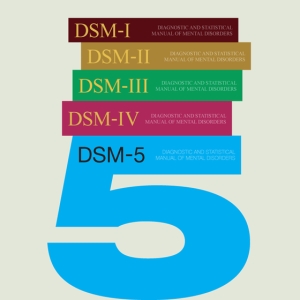What do clinicians diagnose with?
The Diagnostic and Statistical Manual of Mental Disorders (DSM) was originally released by the American Psychiatric Association, when it changed its name in 1921. The DSM-IV-TR and the new DSM 5 are the currently used editions. The DSM 5 is now active, released in 2013, but some agencies, including my own will not be transitioning until later 2015. The DSM is a very large book that uses number coding and criteria to help clinicians and clients classify mental health disorders. The DSM is purely for diagnosing purposes and is not a guide for treatment, nor does it specify guidance for ethical decision making in practice.
Differences between DSM-IV-TR and DSM 5-
1) Change from roman numerals to standard numbers in an attempt to make the DSM 5 more accessible and easy to understand internationally and not just in the US.
2) The last DSM-IV was published in 1992, and had yet to be updated with current terminology, so a revised edition was published but a full DSM rewrite was not started until 1999. Very important to stay current!
3)The DSM-IV-TR was written from a medical model, by medical and psychiatric professionals, and did not include counseling professionals feedback. The DSM 5 was written from a variety of outlooks with professionals from many fields contributing to the contents.
What is a diagnosis?
The numerical diagnosis code, for example 300., is given for ease of categorizing, and is not as intimidating as it appears. For example, the diagnosis that associates with the code 300.00 is Anxiety Disorder NOS. NOS meaning=not otherwise specified (it doesn’t fit the criteria for a more specific anxiety disorder). Addition .XX numbers can be added as specifers for things like mild, moderate, and severe. Additional specifiers can be added for acute or chronic, these depend on the specific diagnosis.
So is it good or bad?
Simple answer…..it depends.
A diagnosis is often the most associated stigma within mental health counseling. Over-diagnosing, poor diagnostics, and lack of client psychoeducation leads to stigma in the field and anxiety from both clients and clinicians. A diagnosis is given to help classify and standardize the assignment of clinical treatment. The diagnosis can be helpful to ensure that standards and criteria are being followed in order to diagnose accurately. Tricky part is that diagnosis, unfortunately, is subjective so what applies for one client and one clinician can be different from one therapy setting to the next. For example, a substance abuse clinic will most like place the chemical dependency or abuse diagnosis as the primary, while a mental health agency might place it as a secondary diagnosis, or may fail to address it at all. Subjectivity can be a good thing however, for those who understand their clients well and may know more details than the criteria can cover itself.
What were your experiences with being assigned a diagnosis?
My professional opinion?
Although I feel I just started to understand the last DSM coding structure, I believe the new DSM 5 is more suitable for working with people in a counseling vs. a clinical setting. The DSM 5 is more user friendly and takes into account the social and environmental factors that influence behaviors. I view diagnosing as a requirement for insurance that is not necessarily needed to understand symptoms, or have effective treatment. It is helpful to be able to collaborate with others in the field, have a specialty area, and understand similarities between clients. I do however, find it is equally important to value diversity, individuality, and having a fresh perspective for each client without get “swept away” trying to make someone fit into a diagnosis category.
People are people. period. It is important to be present and be with the client, not checking boxes in your mind.
Some Additional Information
I included a link to a PDF outline with some of the basic changes made to the new DSM, and a link to more information on the detailed history of the DSM, hope you find it helpful. Any questions please feel free to ask.
Links:
Click to access changes%20from%20dsm-iv-tr%20to%20dsm-5.pdf
http://www.psychiatry.org/practice/dsm/dsm-history-of-the-manual



It is important to be present and be with the client